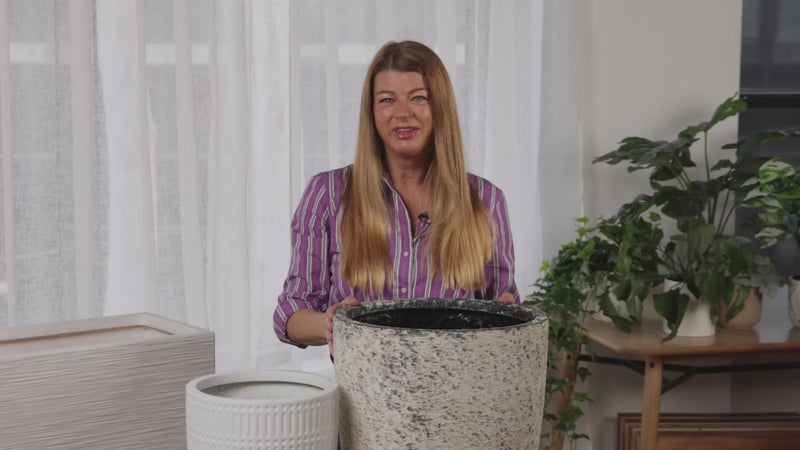
Potting Mix Calculator
How much potting mix do I need?
Use our free potting mix calculator as a guide to determine how much potting mix you need for your planter.

How to measure your pots
Preparing to measure
- For round pots, measure the internal diameter from edge to edge.
- For rectangular pots, measure both the internal width and length.
- For all shapes, measure the internal depth from rim to base.
Considerations for the amount of potting mix
- The size of the plant selected and its root ball
- Potting mix can settle over time
- Always seek extra guidance from your garden centre or nursery plant expert
Take the Guesswork Out of Potting Mix
Potting mix is crucial for healthy plant growth in container gardening. With our easy-to-use calculator, you can determine the amount of potting mix your plants need, helping to reduce waste. Whether you're using round or rectangular pots, our tool considers the shape and size of your containers.
What is potting mix?
Potting mix is a specially formulated blend of materials designed to provide the perfect growing environment for plants in containers. Unlike garden soil, which can be too heavy and compacted for pots, potting mix is light, well-draining and nutrient-rich, allowing your plants to grow and thrive.
Is potting mix the same as soil?
No, potting mix and soil are not the same. Potting mix is specifically designed for container gardening and provides the right balance of drainage, aeration, and nutrients. Soil, on the other hand, is naturally occurring in the ground and can be too heavy or compact for plants in pots.
How much potting mix do I need?
Use our calculator to find out how much potting mix you’ll need to fill your pot. Simply measure the diameter and width, as well as the height or depth of your pot, and input these values. The calculator will provide an estimate of how much potting mix you’ll require, based on the full volume of your pot. Remember potting mix can settle over time, so you may need to top your pots up with fresh mix from season to season.
How much perlite should I add to potting mix?
Perlite is a lightweight, volcanic material that is sometimes added to potting mix to improve drainage and aeration. High quality potting mixes are designed to provide the perfect balance of air, water, and nutrients. If you are investing in a good potting mix, you shouldn’t need to add Perlite.
If you want to add perlite to your mix, the amount will depend on the type of plant and its needs. Typically, for standard potting mixes, you can add 10-30% perlite for better drainage, especially for plants that require dry conditions.
How to use potting mix
Northcote Pottery’s outdoor pots are all designed with drainage holes in the bottom to ensure optimal drainage.
Pour the mix into your pot until it reaches the desired level, leaving some space at the top for watering. Plant your plants at the same level as they were in the original grower pot.
For detailed instructions on how to use and measure your planter for potting mix, refer to the ‘How to Measure Your Pots’ video.
How do I measure my pot for the potting mix calculator?
To get accurate calculations, measure the internal diameter for round pots, or the width and length for rectangular pots. Then, measure the internal depth from the rim to the bottom of the pot. Our ‘How to Measure Your Pots’ video shows you exactly how to take these measurements.
Can I use garden soil instead of potting mix?
Garden soil is not recommended for pots. It can become too compacted in containers, leading to poor drainage and root rot. Potting mix is specially formulated to provide the best environment for plants in containers.
Do I need to buy extra potting mix for top-ups?
Yes! Potting mix can settle and decompose over time, which means your pots may need extra mix for top-ups from season to season. A good rule-of-thumb is to purchase an additional 10-15% potting mix for top-up purposes.
Can I add other materials to the potting mix?
If you invest in a good quality potting mix, you shouldn’t need to add additional materials like perlite or vermiculite to the mix. If you are growing plants with specific needs, for example orchids that like a coarse, open growing medium, or cacti and succulents that like a free-draining mix, then look out for potting mixes that are tailor made for that particular plant variety. Some mixes contain extra goodies like controlled release fertiliser, wetting agents, and water-storing crystals to help your plants flourish in pots. All of these can be added to your mix if it doesn’t already contain them. For top growth and performance, our container gardening expert, Melissa King, recommends liquid feeding your pots every two weeks.
Follow the guidelines for your specific plants to achieve the best results.
What is the difference between potting mix and compost?
Potting mix is a growing medium for plants in containers, designed for aeration and drainage. Compost, on the other hand, is an organic material that has decomposed and can be used as a soil amendment. Compost is rich in nutrients and can be added to your potting mix, providing additional benefits. We don’t recommend that you use compost as a substitute for potting mix in containers as it can cause aeration and drainage problems.